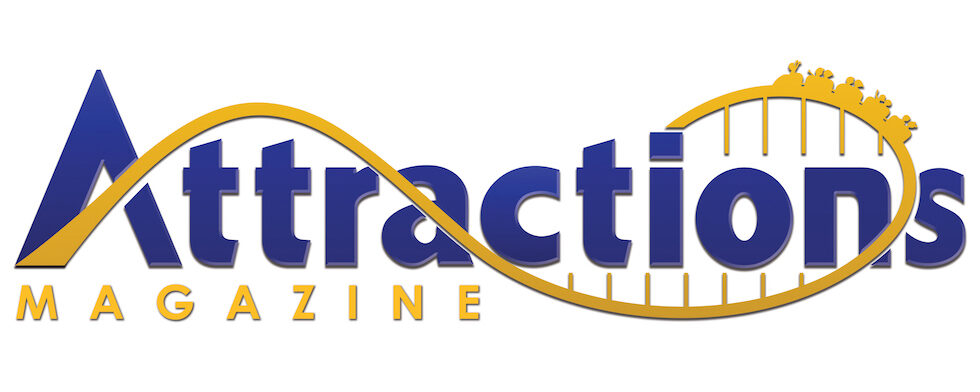Real, ancient, and imagined: 1998’s Animal Kingdom dedication
When Disney’s Animal Kingdom opened in 1998, then-Disney CEO Michael Eisner provided a 44-word dedication for the park, a thesis of sorts for why the park exists. As Animal Kingdom celebrates its 25th anniversary, how do these words hold up a quarter of a century later? Have Imagineers’ intentions for the park changed since then?
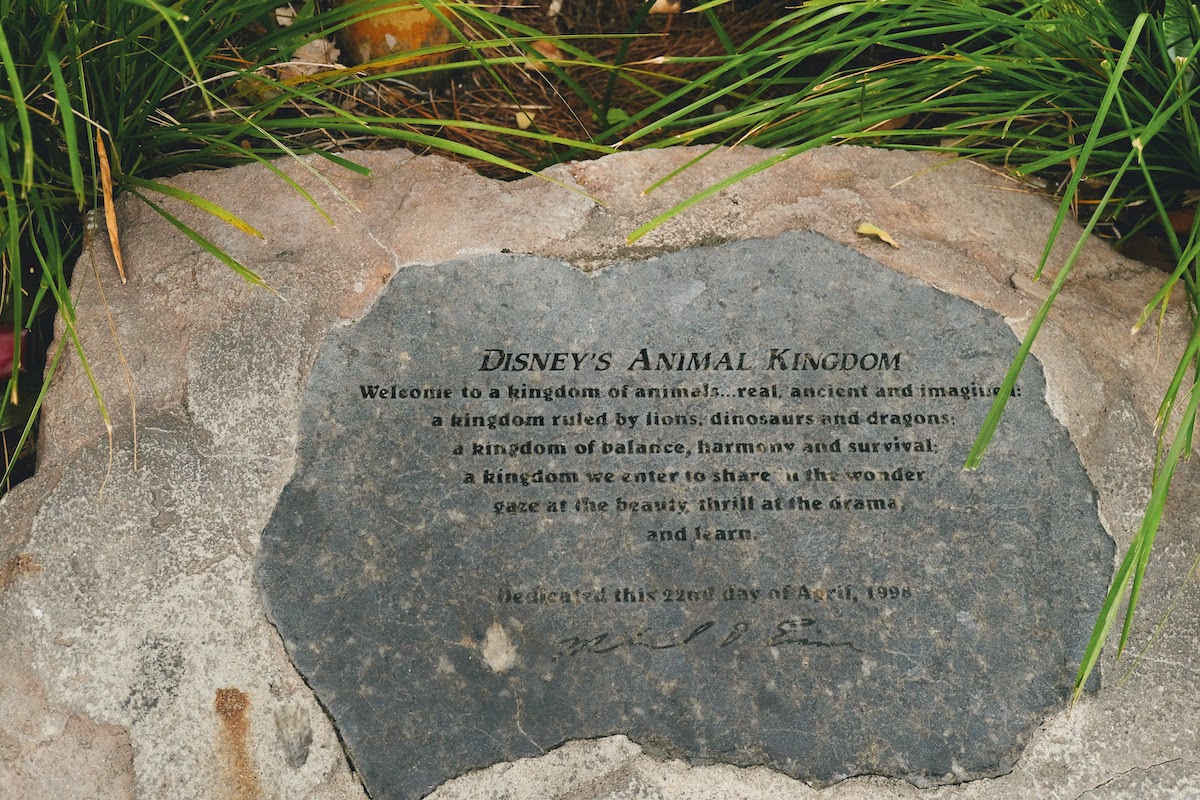
Michael Eisner’s Dedication of Animal Kingdom
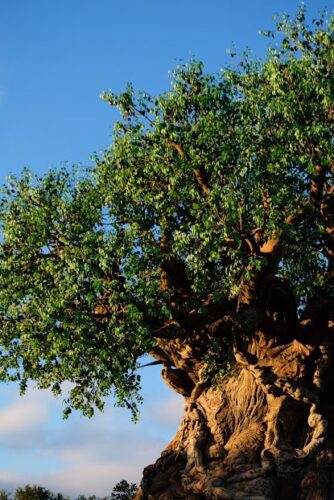
Let’s travel back in time for a moment. It’s the morning of April 21, 1998. Imagineers, Cast Members, and invited press are gathered to celebrate the official grand opening of Disney’s Animal Kingdom. The park will open to the public tomorrow, Earth Day. Hosting the fanfare the day before will help things run smoother for the first public operating day.
Eisner approaches the podium to address the crowd. Moments earlier, the audience heard remarks from Roy E. Disney and enjoyed a performance by Lebo M., the songwriter and vocalist behind the iconic African rhythms of “The Lion King.” Eisner acknowledges and thanks the people who made Animal Kingdom a reality, including Dr. Jane Goodall, seated among the crowd.
At 8:17 a.m., Eisner speaks the park’s formal dedication, “as is the Disney tradition,” he notes. This oration, Eisner says, “captures our ambition in creating the park.”
Eisner’s dedication of Disney’s Animal Kingdom is as follows:
Welcome to a kingdom of animals… real, ancient, and imagined: a kingdom ruled by lions, dinosaurs, and dragons; a kingdom of balance, harmony, and survival; a kingdom we enter to share in the wonder, gaze at the beauty, thrill at the drama, and learn.
Note: the ellipses after the word “animals” appear on the dedication plaque itself. They do not indicate the removal of extra words like ellipses typically do.
Let’s break down the three key animal areas Eisner highlighted in his speech — “real, ancient, and imagined” — and explore how they applied to guests’ experiences at the park in 1998 and still apply today.
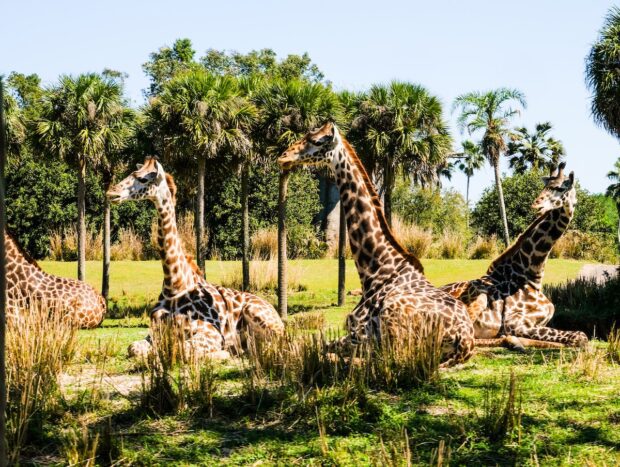
Real Animals
Most obvious among Eisner’s three groups are the real animals that guests encounter throughout the park. The park’s signature animal-viewing attraction, Kilimanjaro Safaris, debuted with the park on opening day 1998. Guests could also view gorillas and meerkats at Gorilla Falls Exploration Trail and pet goats at Conservation Station, experiences that are still open today. (Some of the animals themselves have even been at the park since opening.)
The park’s Asia section wouldn’t open until 1999, but once it did, Maharajah Jungle Trek offered an additional walk-through trail with tigers, which are also still part of the lineup.
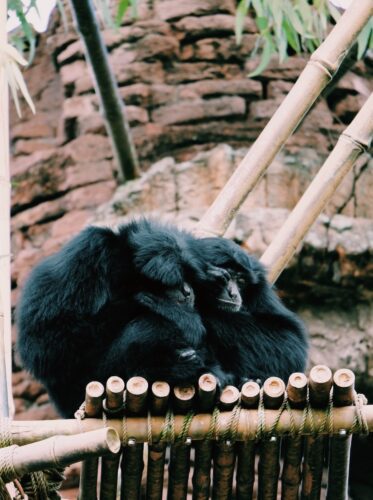
Part of the beauty of Animal Kingdom has always been its emphasis on spontaneity. Among the bustle of dining reservations, Lightning Lanes, and showtimes, the park invites guests to embrace the spirit of discovery — to truly explore its less-traveled paths and soak in its details. When they do, guests will find an abundance of animal habitats that aren’t part of any formal attraction, but are equally delightful, from the otters of Discovery Island to the crocodiles of DinoLand U.S.A. (The birds by the swinging bridge and cavern in The Oasis are a personal favorite hidden gem of mine.)
One of the most thrilling live-animal experiences to open in recent years is “Winged Encounters: The Kingdom Takes Flight.” In a blink-and-you’ll-miss-it moment, a flock of gorgeously colorful macaws swoops over guests’ heads before landing on a perch near the central plaza in front of the Tree of Life. It’s an exhilarating sight that catches many folks by surprise.
As part of the circle of life, the park continually welcomes new animals to make their home at Animal Kingdom. This includes those born onsite as offspring of the park’s existing residents.
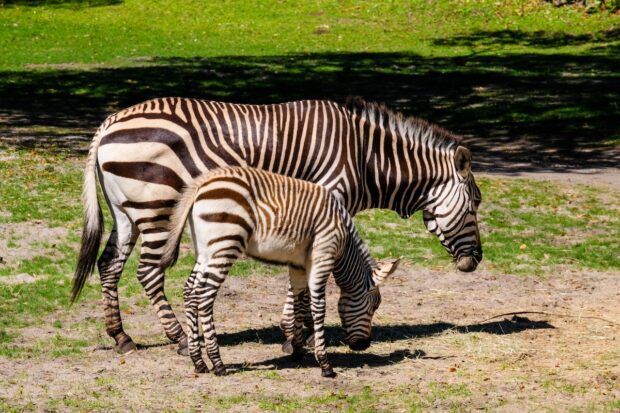
Ancient Animals
Moving on to Eisner’s second point. When it comes to ancient animals, one species seems to pique the public’s interest more than others: dinosaurs. DinoLand U.S.A. welcomed guests to the fictional Diggs County when Animal Kingdom opened in 1998. At that point, the area only consisted of the Dinosaur attraction (then called “Countdown to Extinction”), The Boneyard, Restaurantosaurus, and a walk-through museum in a tent. While the gift shop Chester & Hester’s Dinosaur Treasures existed on opening day, its namesake characters’ nearby Dino-Rama and accompanying midway attractions wouldn’t come until 2001.

DinoLand presents a fun contrast of two very different interpretations of dinosaurs, as Imagineer Alex Wright details in his 2007 book, “The Imagineering Field Guide to Disney’s Animal Kingdom.”
Guests paying attention may observe a socioeconomic conflict of sorts throughout the vicinity. Folks at the Dino Institute (where Dinosaur takes place) believe paleontology should be taken seriously. By comparison, entrepreneurs Chester and Hester don’t mind imagining a silly side to dinosaurs by means of “roadside” attractions. Meanwhile, according to the backstory, grad students who live in Restaurantosaurus are just trying to get through school.
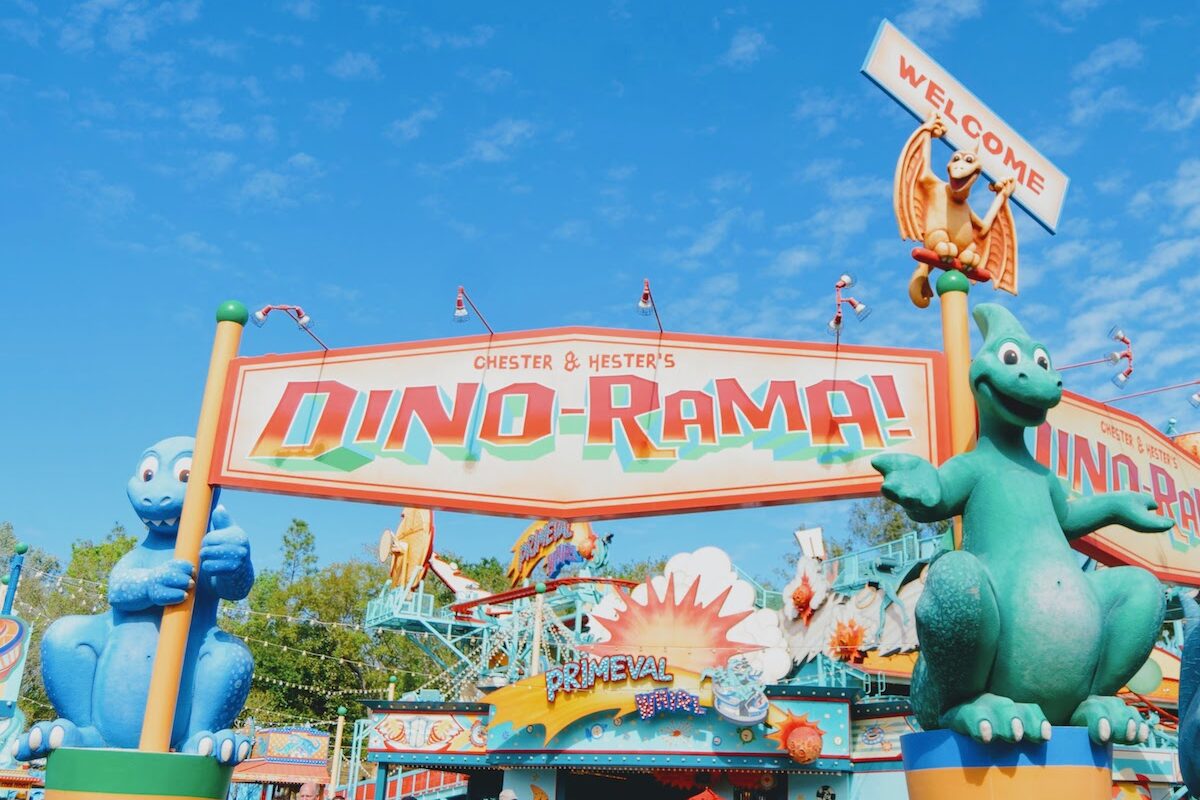
These layers of the DinoLand story (and the conflict among them) may not be obvious to all guests; however, the story is there if you’re looking for it. It offers a surprisingly nuanced discussion about how to approach the idea of extinct animals (albeit one that’s nearly impossible to discern without research, and that most people miss among the intentional kitsch).
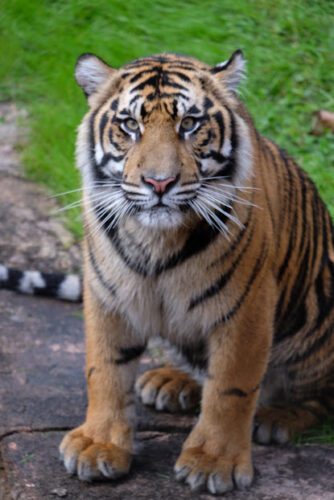
Beyond DinoLand, one could argue the park’s efforts to educate guests about endangered species could fall into the “extinct” category. These initiatives would still be present even if DinoLand closes in the future. After all, if not protected, endangered creatures will soon become extinct, qualifying as “ancient.” Granted, there’s certainly a tension between focusing on the hope that’s still left for endangered animals rather than leaning into the inherently morbid aspect of the concept.
Imagined Animals
The realm largely missing from Animal Kingdom’s opening day was the third category Eisner listed, imagined animals, and in fact, the CEO specifically mentioned a dragon in his speech. The imaginary creature was also featured on the park’s logo, alongside other animals. However, the only dragon guests could find on opening day was a bit of a disappointment. On the now-defunct Discovery River Boats, guests saw a blast of fire emanating from a cave. Perhaps taking Eisner’s words to unintentional extremes, guests could “imagine” the dragon hidden inside the cave, out of sight.
The presence of classic Disney characters in the park could qualify as imaginary, as the park has always hosted a handful of animated pals. In 1998, this included the now-closed Camp Minnie-Mickey, the park’s dedicated hot spot for character greetings and also home to shows starring characters from “The Lion King” and “Pocahontas.”
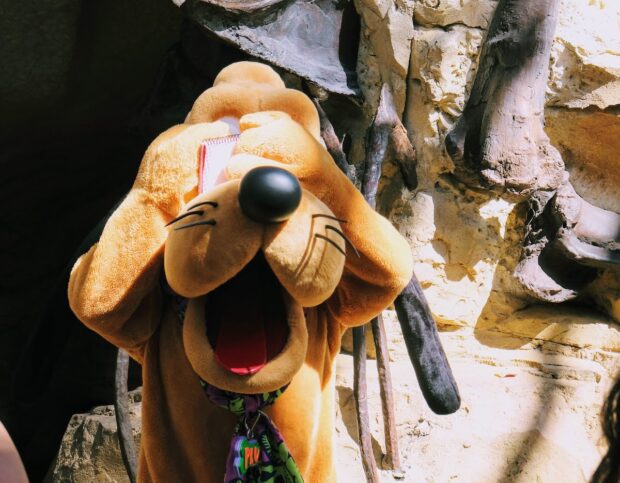
As Animal Kingdom expanded over the years, the concept of mythical creatures took on new form. Expedition Everest introduced its monstrous yeti, while Pandora – The World of Avatar established a home for the Na’vi population, the native creatures of Pandora.
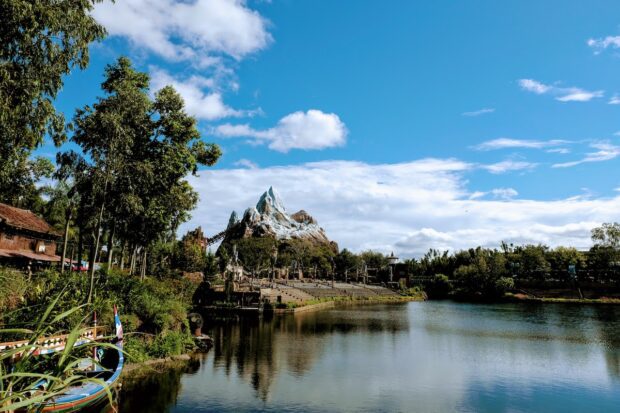
The Dedication Evolves

Eisner’s dedication in 1998 served as a purpose statement for the park. However, his exact words probably shouldn’t be taken as unbending requirements for new additions to the park.
Throughout Disney history, several parks have undergone serious overhauls that reflected an evolution from their original themes. Notably, the recent transformations of Epcot and Disney’s Hollywood Studios include additions that challenge their respective park’s dedication plaque and offer something new.
On the whole, Disney doesn’t seem too concerned whether or not a park’s menu of attractions lines up perfectly with what its opening-day dedication lays out, and I think that’s okay. While a theme is important, adhering to specific phrasing limits the parks’ futures. The plaques are neat little nods to history, not bylaws.
There’s one interesting exception to Disney leaving dedications as-is. In 2012, Disney California Adventure opened Buena Vista Street and Cars Land at the conclusion of its multi-year expansion. At that time, Disney CEO Bob Iger re-dedicated the park. His words abridged former CEO Eisner’s 2001 dedication and a new plaque dated 2012 was installed at the park’s entrance. In this case, Disney must have considered the park’s changes significant enough to warrant an updated legislature, as it were.
Where To Find Michael Eisner’s Dedication Plaque In Animal Kingdom
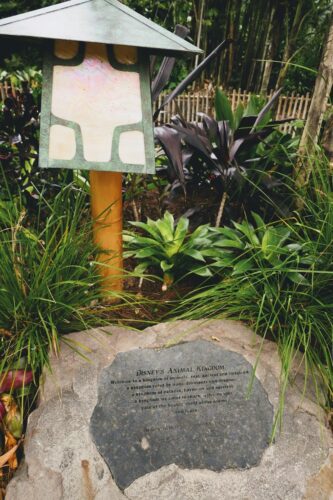
If you’d like to see Michael Eisner’s words etched in stone for yourself, look no further than the front entrance of Animal Kingdom. Just past the tapstiles, two diverging paths on either side of a wooded animal habitat lead guests into The Oasis. Rather than beelining in either direction, walk directly toward the center of the wooded area. There you’ll find a lantern positioned near a rock, where the Animal Kingdom dedication welcomes guests to their adventure.
Dedication plaques from opening day also exist at all three other Walt Disney World theme parks:
Roy O. Disney’s 1971 dedication for Magic Kingdom is located at the flagpole, Card Walker’s 1982 dedication for Epcot can be found before the park’s tapstiles, and Michael Eisner’s 1989 dedication for Disney’s Hollywood Studios (then Disney-MGM Studios) is located next to the director statue on Hollywood Boulevard.

